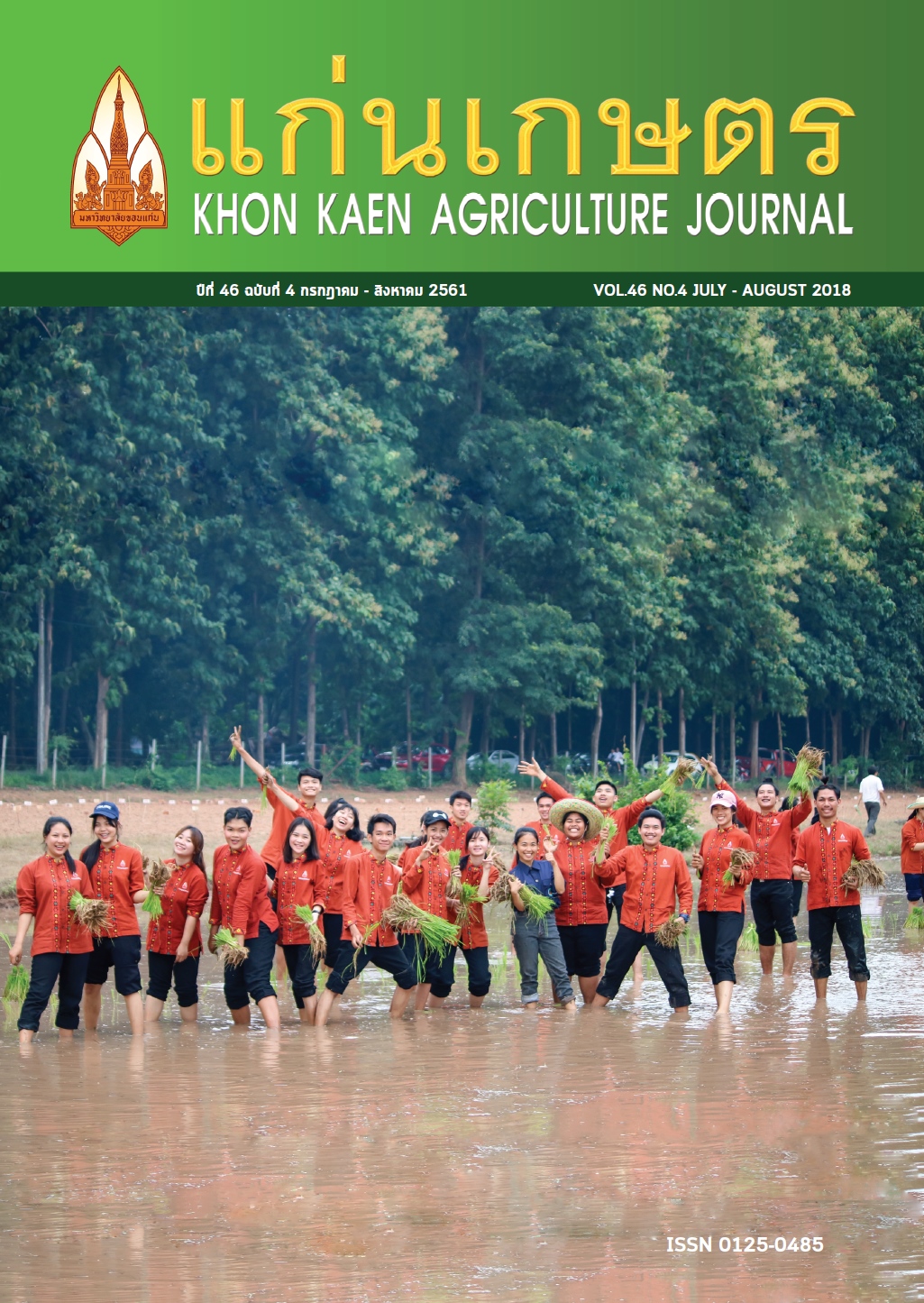อิทธิพลของปุ๋ยโพแทสเซียมต่อผลผลิตและองค์ประกอบผลผลิตของข้าวเหนียวที่ปลูกในสภาพดินเค็ม
Main Article Content
บทคัดย่อ
ดินเค็มส่งผลให้ข้าวมีการเจริญเติบโตและผลผลิตลดลง โพแทสเซียมเป็นธาตุที่ช่วยให้พืชมีความทนทานต่อความเค็มได้ดีขึ้น การให้ปุ๋ยโพแทสเซียมอย่างเหมาะสมกับข้าวที่ปลูกในดินเค็มน่าจะช่วยทำให้ได้ผลผลิตสูงขึ้น วัตถุประสงค์ของการทดลองเพื่อศึกษาอิทธิพลของอัตราปุ๋ยโพแทสเซียมต่อผลผลิต องค์ประกอบผลผลิตและสหสัมพันธ์ระหว่างผลผลิตและองค์ประกอบผลผลิตของข้าวเหนียว (กข 6) ภายใต้สภาพดินเค็ม ทำการทดลองในกระถางประกอบด้วย 2 ระดับความเค็มและอัตราปุ๋ยโพแทสเซียม 5 อัตรา พบว่า ผลผลิตข้าวลดลงอย่างมีนัยสำคัญเมื่อปลูกในสภาพดินเค็มที่ระดับ 6 เดซิซีเมนต์/ม. การให้ปุ๋ยโพแทสเซียมที่อัตรา 0.15 ก. K/กระถาง กับข้าวที่ปลูกในดินเค็มที่ระดับ 6 เดซิซีเมนต์/ม. ทำให้ผลผลิตข้าวเพิ่มขึ้นถึง 7.7 ก./กระถาง เมื่อเปรียบเทียบกับข้าวที่ไม่ใส่ปุ๋ยโพแทสเซียมซึ่งได้ผลผลิต 3.4 ก./กระถาง เมื่อพิจารณาสหสัมพันธ์ของผลผลิตข้าวที่ปลูกในดินเค็มกับองค์ประกอบผลผลิตพบว่ามีความสัมพันธ์ในเชิงบวกกับน้ำหนักฟาง จำนวนเมล็ดดีต่อกระถาง น้ำหนัก 1,000 เมล็ด มวลชีวภาพ และดัชนีเก็บเกี่ยว การให้ปุ๋ยโพแทสเซียมอัตรา 0.15 ก. K/กระถาง ทำให้ผลผลิตข้าวที่ปลูกในดินเค็มสูงขึ้นโดยช่วยเพิ่มลักษณะองค์ประกอบผลผลิตที่เกี่ยวข้อง
Article Details
เอกสารอ้างอิง
กรมการข้าว. 2561. องค์ความรู้เรื่องข้าว. https://bit.ly/2nykCSn. ค้นเมื่อ 29 มกราคม 2561.
คณาจารย์ภาควิชาปฐพีวิทยา. 2548. ปฐพีวิทยาเบื ้องต้น. พิมพ์ครั้งที่ 10. สำนักพิมพ์มหาวิทยาลัยเกษตรศาสตร์, กรุงเทพ ฯ.
Arunin S., and P. Pongwichian. 2015. Salt-affected soils and management in Thailand. Bull Soc. Sea Water Sci. Jpn. 69: 319–325.
Cerezo, M., P. Garcia-Agustin, M. D. Serna, and E. Primo-Millo. 1997. Kinetics of nitrate uptake by citrus seedlings and inhibitory effects of salinity.Plant Sci. 126: 105-112.
Cha-um, S., Y. Pokasombat, and C. Kirdmanee. 2011. Remediation of salt-affected soil by gypsum and farmyard manure – importance for the production of Jasmine rice. AJCS. 4: 458-465.
Fageria, N. K. 2014. Mineral Nutrition in Rice. Boca Raton, FL: CRC Press. Joseph, B., D. Jini, and S. Sujatha. 2010. Biological and physiological perspectives of specificity in abiotic salt stress response from various rice plants. AJAS. 2: 99-105.
Kafkafi, U., and N. Bernstein. 1996. Root Growth under Salinity Stress. In: Eshel, A., Y. Waisel, and U. Kafakai (eds) Plant Roots: The hidden half, 2nd ed. Marcel Dekker Inc, New York.
Kanawapee, N., J. Sanitchon, W. Lontom, and P. Theerakulpisut. 2012. Evaluation of salt tolerance at the seedling stage in rice genotypes by growth performance, ion accumulation, proline and chlorophyll content. Plant Soil. 358: 235-249.
Karami, A., M. Homaee, and S. Basirat. 2010. Quantitative and qualitative responses of rice genotypes (Oryza Sativa) to salinity levels of drained water. P. 107–110. In: 19th World Congress of Soil Science, Soil Solutions for A Changing World, August 1–6, 2010 Brisbane, Australia.
Keshavarz, P., M. Nourihoseini, and M .J. Malakouti. 2004. Effect of soil salinity on K critical level for cotton and its response to sources and rates of K fertilizers. IPI Regional Workshop on Potassium and Fertigation Development in West Asia and North Africa; Rabat, Morocco, 24-28 November.
Li, X. P., S. X. Chang, and K. F. Salifu. 2014. Soil texture and layering effects on water and salt dynamics in the presence of a water table: a review. Environ Review. 22: 41-50.
Ranjha, A. M., T. Waheed, S. M. Mehdi, and S. S. Rehman. 2001. Effect of potassium sources on rice yield. IJAB. 3: 69-71.
Römheld, V., and E. A. Kirkby. 2010. Research on potassium in agriculture: needs and prospects. Plant Soil. 335: 155-180.
Von Braunschweig, L. C. 1986. Types of K fertilizers in K replacement strategy. P. 253-262. In: Proceedings of 13th IPI congress, Nutrient balances and the needs for potassium, August 1986, Reims, France. Wakeel, A. 2013. Potassium–sodium interactions in soil and plant under saline-sodic conditions. J. Plant Nutr. Soil Sci. 176: 344-354.
Yuvaniyama, A., C. Dissataporn, P. Pongwichian, and P. Yamclee. 2008. Salinity problems and sustainable management in Nakhon Ratchasima province, northeast Thailand. In: Proceedings of 2ndinternational salinity forum, March 2008, Adelaide, Australia.
Zain, N. A. M., and M. R. Ismail. 2016. Effects of potassium rates and types on growth, leaf gas exchange and biochemical changes in rice (Oryza sativa) planted under cyclic water stress. Agricultural Water Management. 164: 83-90.
Zeng, L., and M. C. Shannon. 2000. Salinity effects on seedling growth and yield components of rice. Crop Science. 40: 996-1003.


